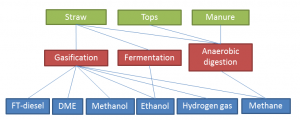Residues from agriculture include a variety of products, such as straw from cereal and oilseed cultivation, tops from potato and sugar beet cultivation, and manure from livestock keeping. All of these can be used for biofuel production in different ways. Using residues is a way of increasing energy production from agriculture without competing with food production.
Straw
Straw is the stalks from cereal or oil plants. Straw can be harvested or left in the field for different reasons: because there is no demand for it, to maintain soil quality, or because the weather or time does not allow for collection. The straw harvested in Sweden is mainly used as bedding material and feedstuff for animals, but the excess straw could be used for energy purposes. Fuel qualityfor different types of straw vary and wheat straw is commonly considered as suitable due to e.g. high yields and low content ofash. The content of alkali metals and chlorine can be reduced if the straw is left in the field and exposed to rain before harvesting.
Harvesting of cereal is done with a harvesting combine that cuts the plants and feed them into a thresher where grains are separated from the straw. The straw is then placed in rows on the field for collection. The straw yield varies with respect to species and stubble height, but is generally in the range of 1-5 tonnes dry matter/hectare.
There are many systems to collect and store straw. Capacity is always important when collecting straw, due to economic and time constrain reasons. The straw can be pressed into square or round bales, with square bales usually having a higher density and also being easier to transport and store because of their shape. Another method for collection is to load chopped straw directly onto a collecting trailer. The expenses for baling can then be avoided, but chopped straw has low density, making transportation and storage expensive.
When straw that is not dry enough is stored, it can lead to molding and spores can spread that could cause health problems such as lung disease. It also leads to dry matter losses, heat development and risk of self-ignition. The straw can hold sufficiently low moisture content at point of collection, but the moisture content is very weather dependent.
Potato and sugar beet tops
Tops that remain from cultivation of potato and sugar beet is currently a non-utilized feedstock with potential for harvesting asfeedstock for anaerobic digestion.
In potato cultivation the tops are terminated about three weeks prior to harvest, to prevent mold contaminated green tops to cause damage to the potatoes, and to make the harvesting easier. In conventional farming this is done by spraying the tops with herbicides, and in organic farming it is done mechanically by breaking or burning of the tops. In most cases, the tops are left on the field. There is no standard collecting method yet developed. However, there is ongoing research, including development of a front mounted stem shredder, a side mounted elevator and a collecting trailer. Harvest is estimated to vary between 1-4 tonnes dry matter/hectare.
In sugar beet cultivation the tops are generally left on the field, but can be collected during the harvest. Many beet harvesting machines can separate the tops from the beet, and by using an elevator they can be collected in a trailer. The harvest of beet tops varies between 3-8 tonnes dry matter/hectare. However, removing tops from the field also removes nutrients. This could be compensated for by returning sludge from the anaerobic digestion to the field.
Manure
Manure is the feces and urine from livestock. There is a distinction between liquid manure with a low content of dry matter, and solid manure with a higher content of dry matter that is mixed with bedding materials like straw and feeding residues. In principal all manure in Sweden is used as a fertilizer on farmland.
Storing of manure leads to emissions of methane as the organic matter decomposes. Therefore, manure is a good substrate for anaerobic digestion as this method avoids emissions of methane to the atmosphere, and at the same time allows for energy production. However, manure often needs to be co-digested with other substrates as the methane yield is rather low.
Current production and potential
The estimated total amount of straw available on Swedish fields corresponds to an energy potential of about 27 TWh per year. Dueto weather conditions and time constraints during harvest season it is not possible to harvest all of it. Some straw also has to be leftin the field in order to maintain soil quality, and some is needed as bedding material for livestock. This taken into account, the potentialfor use of straw for energy purposes in Sweden is estimated to around 4 TWh per year. Another 5 TWh is harvested as beddingmaterial in livestock keeping, from which a large share will end up as manure that can also be used for energy purposes.
The annual potential for tops is estimated to about 0.4 TWh from potatoes and 1 TWh from sugar beets.
The current Swedish livestock population produces manure with an energy potential of approximately 14 TWh per year. This also includes the manure that ends up on pasture land during grazing season. Studies of biogas potential from collected manure range between 4-6 TWh per year, depending on assumed biogas yield, number of animals, amount of manure and grazing period. The total production of biogas from manure was about 210 GWh in 2012, of which 145 GWh was upgraded to vehicle gas.
